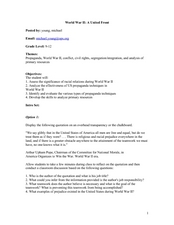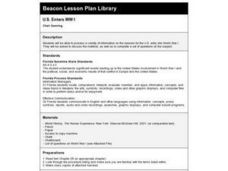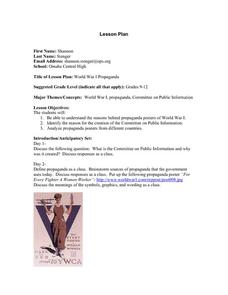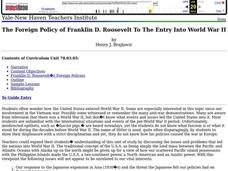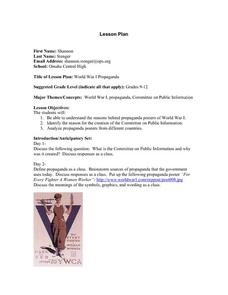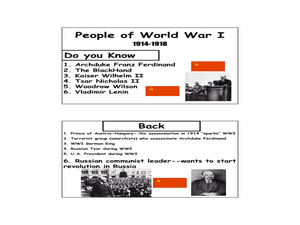Curated OER
The War: Japanese Americans and Internment
Students examine the experiences of Japanese-Americans at the beginning of World War II in America. After watching an excerpt from "The War", they answer reflection questions about the Japanese being put into internment camps. In groups,...
Curated OER
The First World War
In this World War I worksheet, students review a chapter as they match 5 men to their accomplishments, read 5 false statements then make them true, and identify 2 historical themes pertaining America's role in the war.
Curated OER
World War II: Causes and Consequences
Tenth graders examine Hitler's occupation of Europe and the Allies' efforts to fight it. For this World War II lesson, 10th graders examine how World War II changed American society, especially for women. Students analyze a...
Curated OER
World War II: A United Front
Students interpret historical evidence presented in primary resources. In this World War II lesson, students examine racial relations during the war and then examine propaganda techniques employed by the United States...
Curated OER
World War II Erupts Chapter Review
In this World War II worksheet, students review a chapter as they write 10 vocabulary words that match 10 descriptions, eliminate 4 false sentences, and identify 2 themes from the history of the World War II era.
Curated OER
Where in the World War? Mapping WWII in the Pacific
Students explore the Pacific Theatre of War. In this World War II lesson, students use reference material to access information about significant locations in the Pacific Theatre of War. Students identify the locations of the listed...
Curated OER
Impact of the End of World War II on Japan
Ninth graders examine and discuss reasons United States occupied Japan after surrender in World War II, view photographs of Japan at end of War and explore how U.S. occupation affected Japan's political, economic, and social systems, and...
Curated OER
World War II Through Primary Sources
Seventh graders explore, analyze and study World War II through primary sources to assess the differences and impact of a "world war" vs. "a small war." They critique liberated prisoner letters, describe what they see in photographs and...
Curated OER
The Unseen Army: Conscientious Objectors During World War II
Learners study World War II and why it was called "the Good War". In this World War II lesson students identify the different kinds of conscientious objectors.
Curated OER
Introduction to World War II
Eleventh graders recognize why wars are started and identify and color 3 countries involved with World War II.
Curated OER
World War I and Its Consequences
Tenth graders decipher the long and short term causes of World War I. They follow through by studying the history of the present day situation in the Balkans and simulating peace talks with presentations.
Curated OER
End of World War II
Ninth graders examine the results of the Yalta Conference on Europe after the war. They develop a PowerPoint presentation that compare the effects of World War I and World War II. They write a journal entry taking the point of view of...
Curated OER
AMERICAN INVOLVEMENT IN WORLD WAR II: THE PACIFIC THEATER 1941-1945
Tenth graders describe roles of key figures in the Pacific Theater of war during World War II. In this American History lesson plan, 10th graders research key events of the Pacific Theater of War during World War II. Students...
Curated OER
U.S. Enters World War I
Students explore the reasons why the United States entered into World War I and how that conflict effected the United States and Europe politically, economically and socially.
Curated OER
World War I Propaganda
Learners interpret historical evidence presented in primary and secondary resources. In this World War I lesson, students examine the propaganda techniques used by different nations during the war and analyze examples. Learners also...
Curated OER
Lead Up to World War II
Twelfth graders examine Hitler's rise to power leading up to World War II. and how the Treaty of Versailles contributed to Hitler's rise to power in Germany. They identify the important countries involved in the beginning of World War II.
Curated OER
The Foreign Policy of Franklin D. Roosevelt To The Entry Into World War Ii
Students examine the U.S.A.'s entry into World War II, and Franklin DO. Roosevelt's foreign policy. They analyze the life of I.E.., the election of 1932, and the New Deal.
Curated OER
Portrayals of Women in World War I
Students explore the contributions of women to the war effort. In this World War I lesson, students examine posters from the era that their instructor has gathered and analyze the message in each of the posters. Students then share their...
Curated OER
United States-Japanese Relations in Post World War II Era
Ninth graders analyze political cartoons and posters relating to the United States and Japan in the period following World War II. They discuss the positive and negative consequences of the United States occupation of Japan.
Curated OER
World War I: Propaganda
Students examine propaganda from the World War I era. Using the examples, they identify how they were able to change the opinions of those viewing it. They discuss whether the United States entered the war to find new markets and further...
Curated OER
People of World War I
In this people of World War I fact card worksheet, students use the notes and picture provided to create a note card for study purposes.
Alabama Department of Archives and History
Extra! Extra! Read All About It?
Remember the Lusitania! As part of their study of the causes of World War I, class members examine newspaper articles and propaganda posters about the sinking of the Lusitania and then craft their own news story about the event.
National WWII Museum
The Red Ball Express: Statistics as Historical Evidence
Historians use all kinds of information to make conclusions ... including statistics. Young scholars examine how two historians evaluate The Red Ball Express—a supply line staffed primarily by African Americans—using numbers. The...
Curated OER
Beginning of World War II
Ninth graders explore how the rise of dictators led to the start of World War II. They identify and explain the main causes for World War II and they explain the causes for the rise of dictators during the 1920's.
Other popular searches
- World War 2 Activities
- World War Two D Day
- Causes of World War 2
- World War 2 Evacuation
- Before World War 2
- World War 2 Map
- Children of World War 2
- World War 2 Causes
- World War 2 Propaganda
- World War 2 Art
- World War Two Battles
- After World War 2



